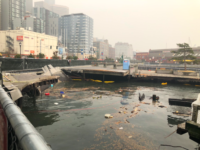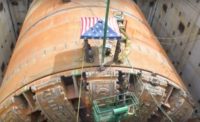Accelerated Pile Deterioration Hastens Seattle Pier Removal

Timber pilings show signs of deterioration on Pier 58. Photo courtesy of Seattle Structural
The city of Seattle is taking emergency steps to dismantle Pier 58, a 46-year-old waterfront park, after an engineering study found deterioration from “natural forces” caused the timber pile-supported structure to shift several inches from an adjacent seawall.
A Seattle Parks spokesperson confirmed that a study suggested accelerated pile deterioration as the cause for the shifting, and recommended the pier’s immediate dismantlement, which was approved Aug. 14 by Mayor Jenny Durkan. A seawall, which was rebuilt in 2017, is unaffected by the pile issues, as are adjacent piers supporting a privately owned aquarium and other tourism businesses, and a city-owned Ferris wheel.
Pier 58 was already scheduled to be replaced beginning in 2022 as part of a $728-million waterfront makeover to replace the now-demolished Alaskan Way Viaduct. Built in 1974, the timber-deck sections that make up the majority of the pier’s 48,230-sq-ft surface area are supported primarily by 341 timber piers that also provide lateral resistance to seismic, wind and wave actions. Two cast-in-place terraces and seawall connections are supported by a combination of concrete-filled monotube piles and steel H-piles.
A 2016 condition assessment by engineering consultant Seattle Structural PS Inc. noted that the loss of creosote treatment over the years had increased the piles’ vulnerability to marine borer attacks.
“Once a pile develops a large number of worm-holes, the rate of decay accelerates and the pile will eventually fail,” the study said.
Seattle Structural also found that the number of piles rated to have no more than 25% of their original 20-ton load capacity had increased from nine in 2006 to nearly 180 in 2016, and that failure of one or more piles was likely by 2021. Because the structure’s original design did not meet current seismic code requirements, the report added, continued timber decay would also increase the structure’s risk of collapse as a result of a seismic or high wind/wave event.
The most likely outcome of a failed pile, the study predicted, was a degree of sagging and reduced live-load capacity. Absent large concentrated loads from vehicles or large events, a collapse resulting from a single pile failure was unlikely, the report concluded.
Based on these findings, Seattle’s Parks Dept. had kept Pier 58 open, with weight restrictions and structural monitoring, pending the scheduled 2022 construction start of a replacement structure. The visual discovery of increased separation between the pier and seawall earlier this month, however, led the agency to close the structure and commission another assessment by Seattle Structural.
Seattle Structural did not respond to a request for comment.
According to a city statement, Seattle’s Office of the Waterfront and Civic Projects will enter into an emergency consultant contract to design removal of Pier 58, and work with the Seattle Dept. of Transportation to expedite permits. A cost and detailed timeline for the project is to be finalized by the end of the month.
Design of the Pier 58 replacement structure is more than half complete, according to the Parks agency. In addition to incorporating light-penetrating surfaces designed to improve the underlying marine habitat, the project will reuse elements of the existing park, including a fountain shaped in cast and welded bronze cubical elements.



